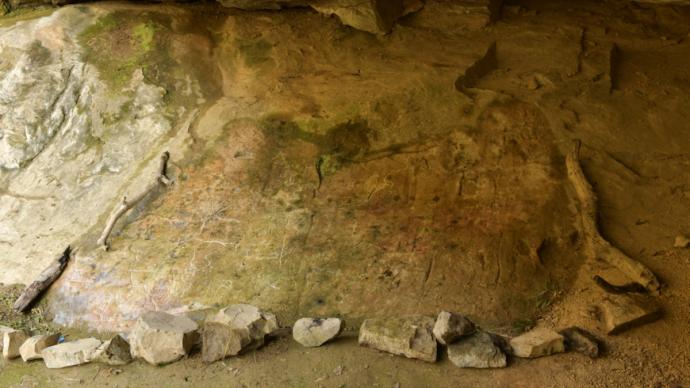
Rock painting is a general term for the color paintings and depictions of ancient ancestors on caves and rock walls. The Taishan Rock Art at Huangzhuguan in Chengxian County, Gansu Province is an ancient rock art discovered for the first time in Longnan. It is speculated that the big and small cliff caves in Shuangyao Gorge of Huangzhuguan are the mines where the Qin people mined gold, and the Taishan rock paintings are relics left by the Qin people when they held sacrifices to pray that the mines would not be flooded by floods. Professor Cai Fuquan, a local epigraph scholar, conducted textual research on the relevant relics. This article intends to try to read the contents of the rock paintings from the symbols and words, and provide some clues to the relevant experts for further study. 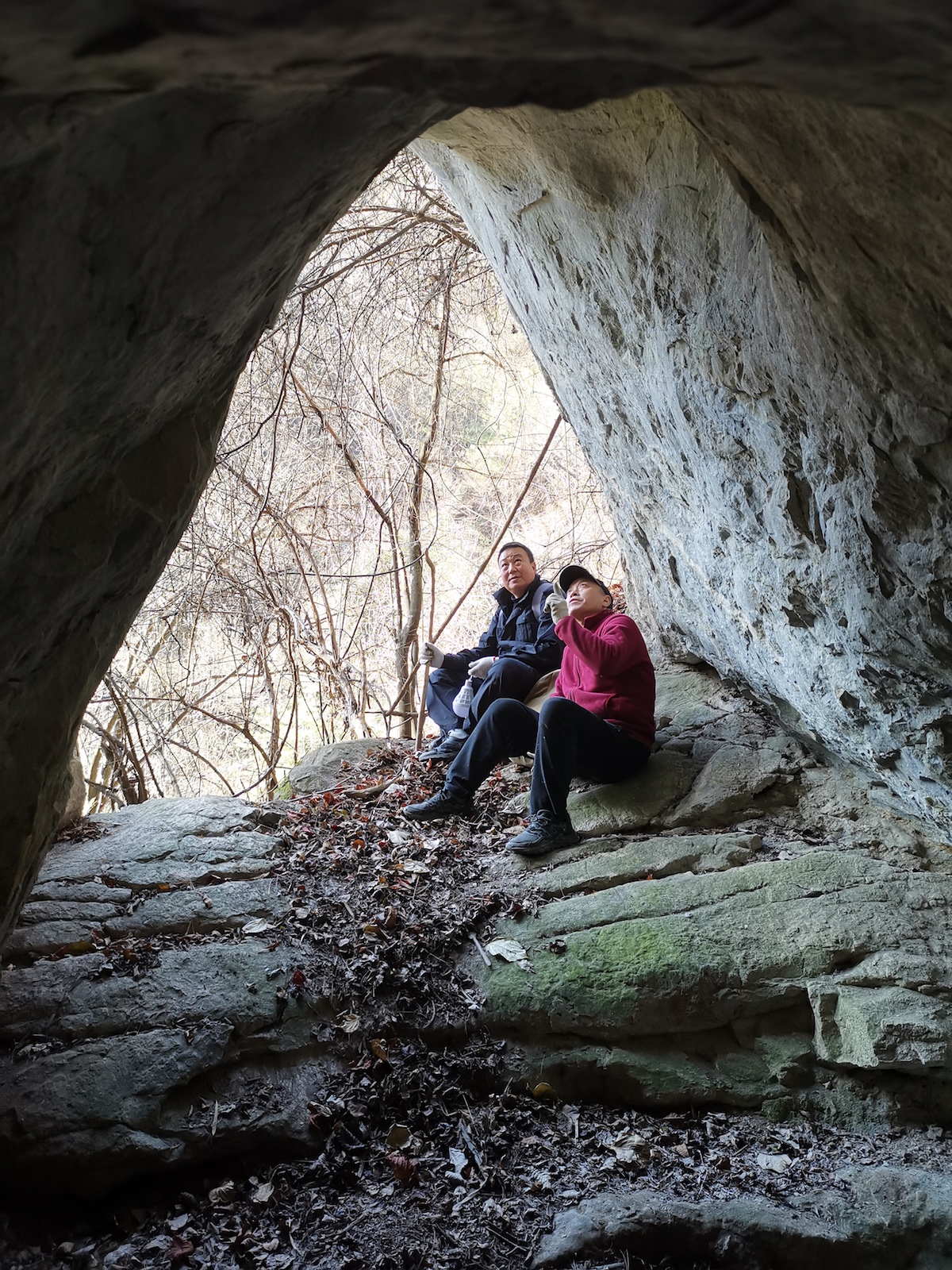
Overview of Taishan Rock Paintings
The rock art is located at the mouth of the ancient mine on the east side of a small stream in Shuangyaoxia, Taishan Village, Huangzhu Town, Chengxian County. Tongkou is about 5 meters high and 6 meters wide, which is unfathomable. The cave body is phyllite, a large amount of loess has poured into the cave due to geological changes, and the high places are plate diagenetic rocks. The petroglyphs are immediately on a slope of the yellow-brown siliceous rock (see Figure 1).
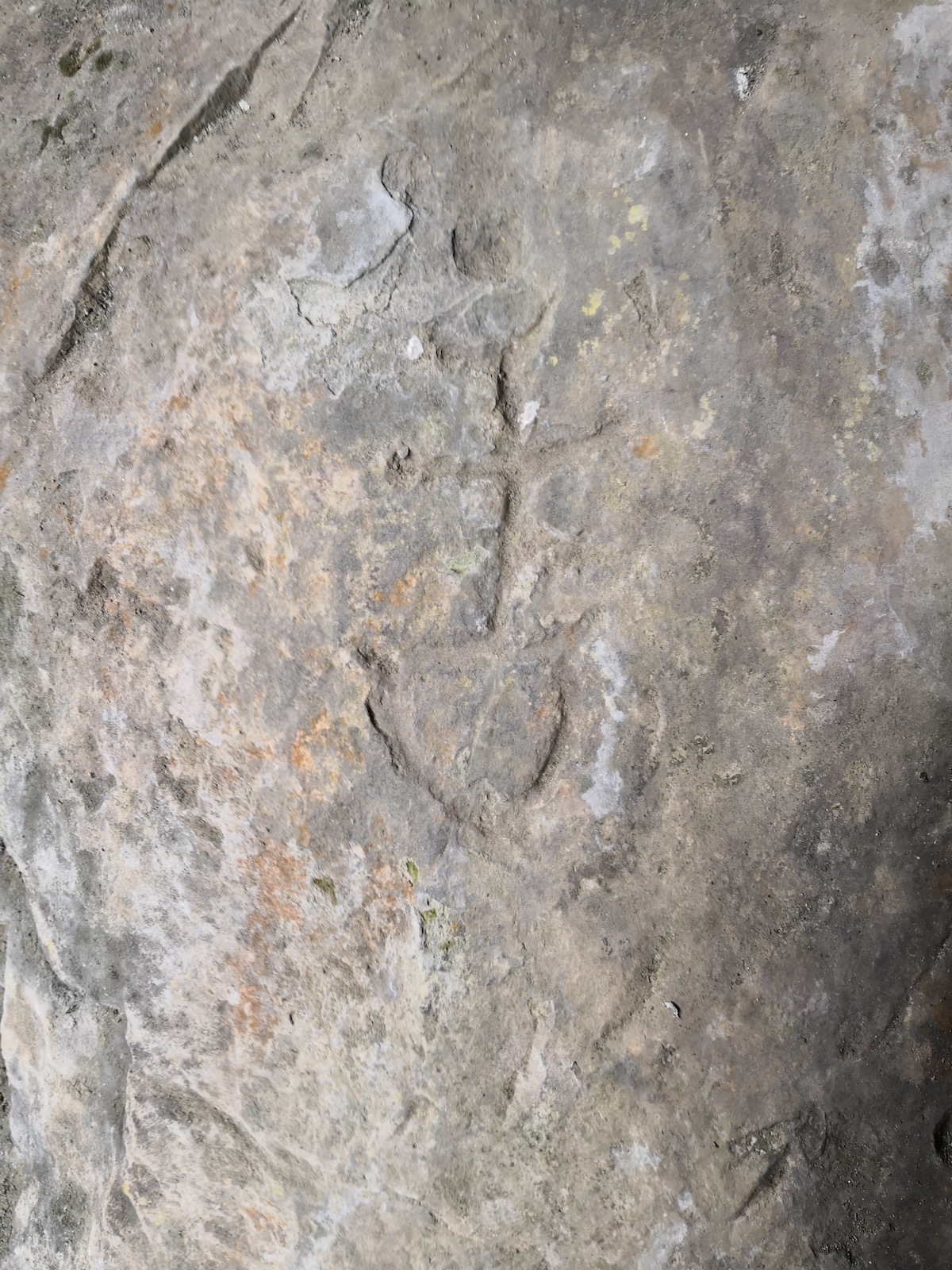

Figures 2 and 3 show the word "Jiaoyu" carved by chisel and chisel. "Gao" is very similar to oracle bone inscriptions. "Gao" is the original character of "祰". Mouth, which is both the side of the form and the side of the voice, means to speak. The upper part of the oracle bone inscription is "ox" (victim) and the lower part is mouth (prayer), which means offering cows to pray for blessings. Jinwen continued the oracle bone script. In official script, the "ox" in the golden script is written as "report", and the original meaning of "prayer" disappears. Here, the top of "Yu" is slightly decorated with a small crown, and the lower part is in the shape of raindrops, which should be the earliest example of the method of making the word "seeking rain".
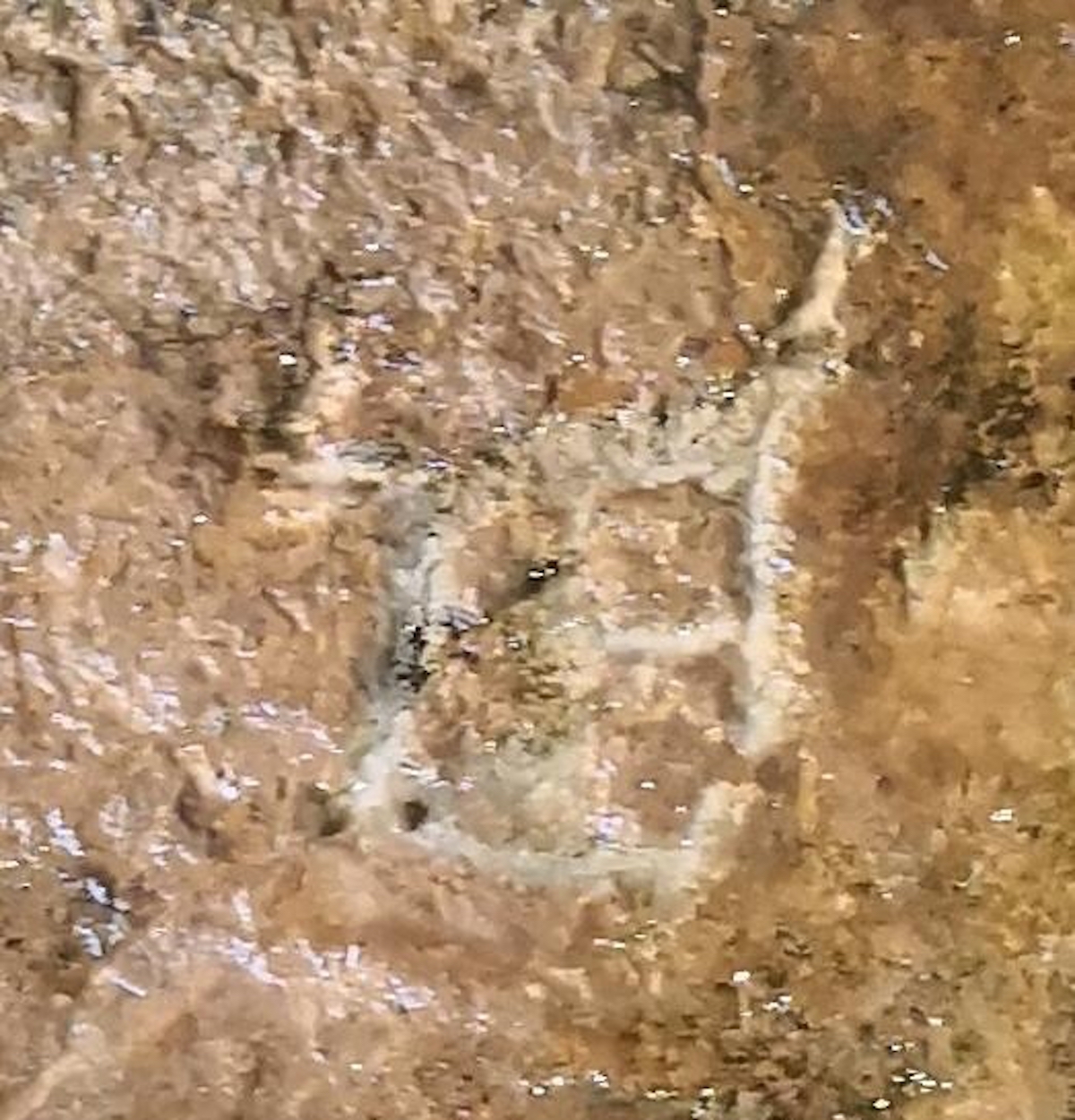

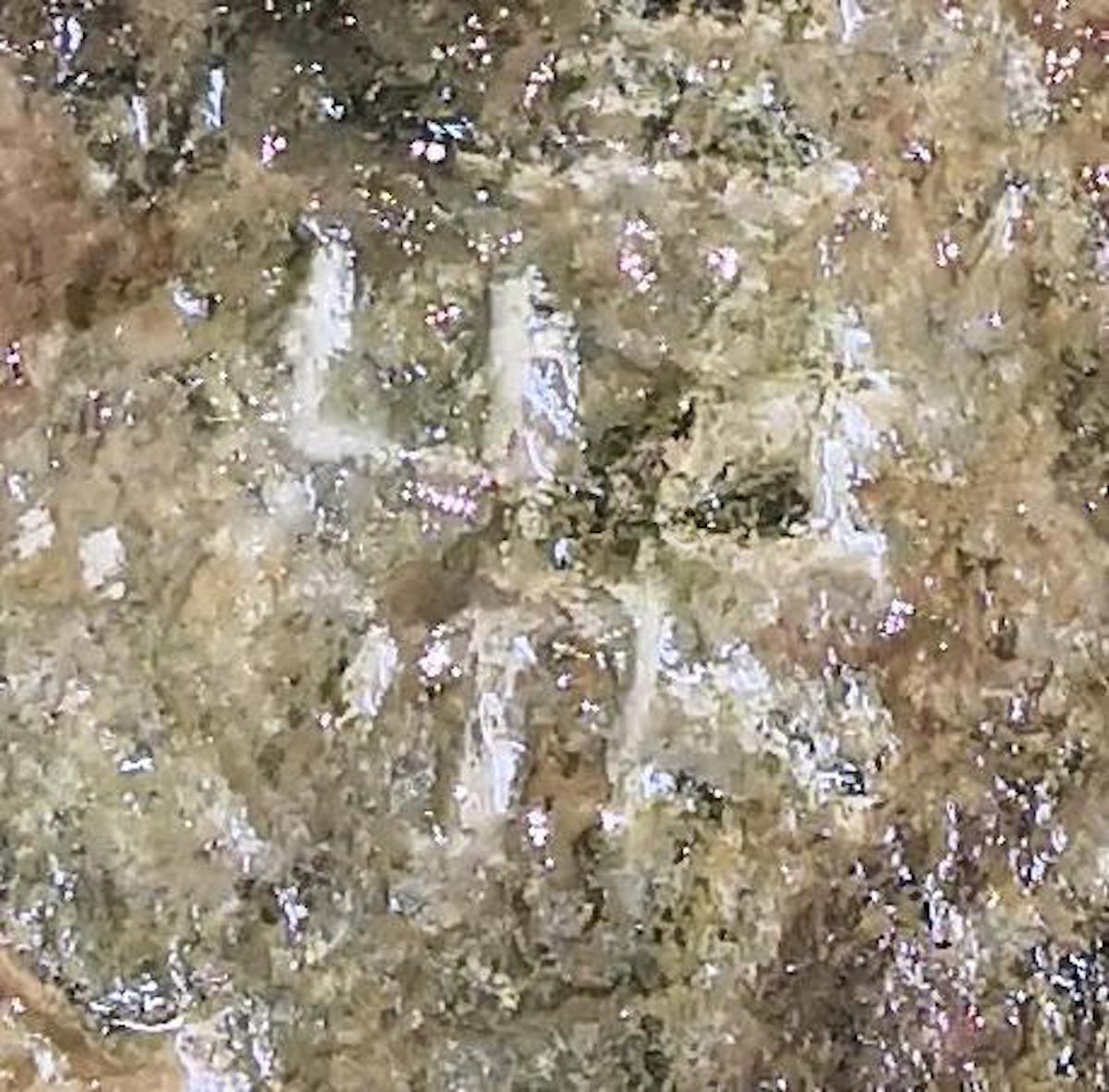
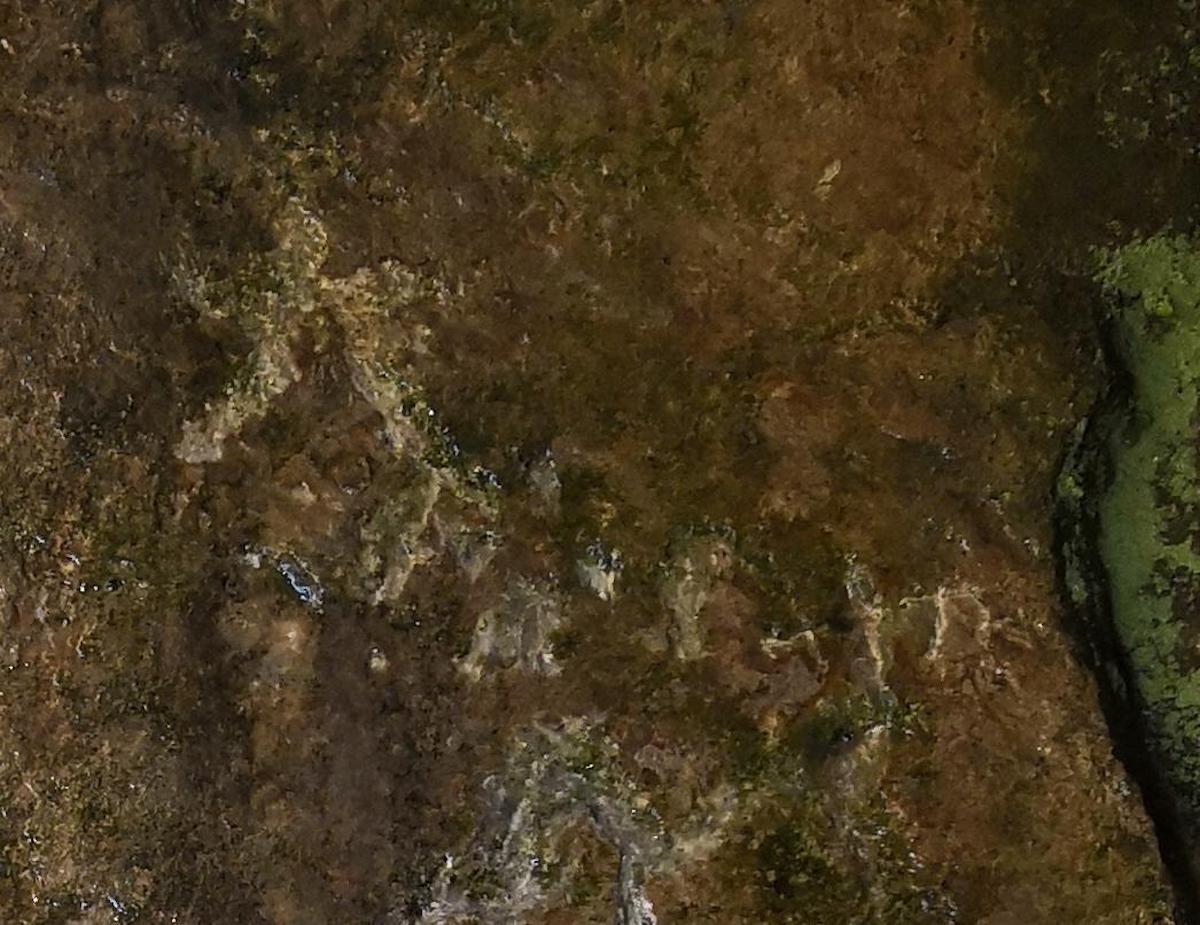
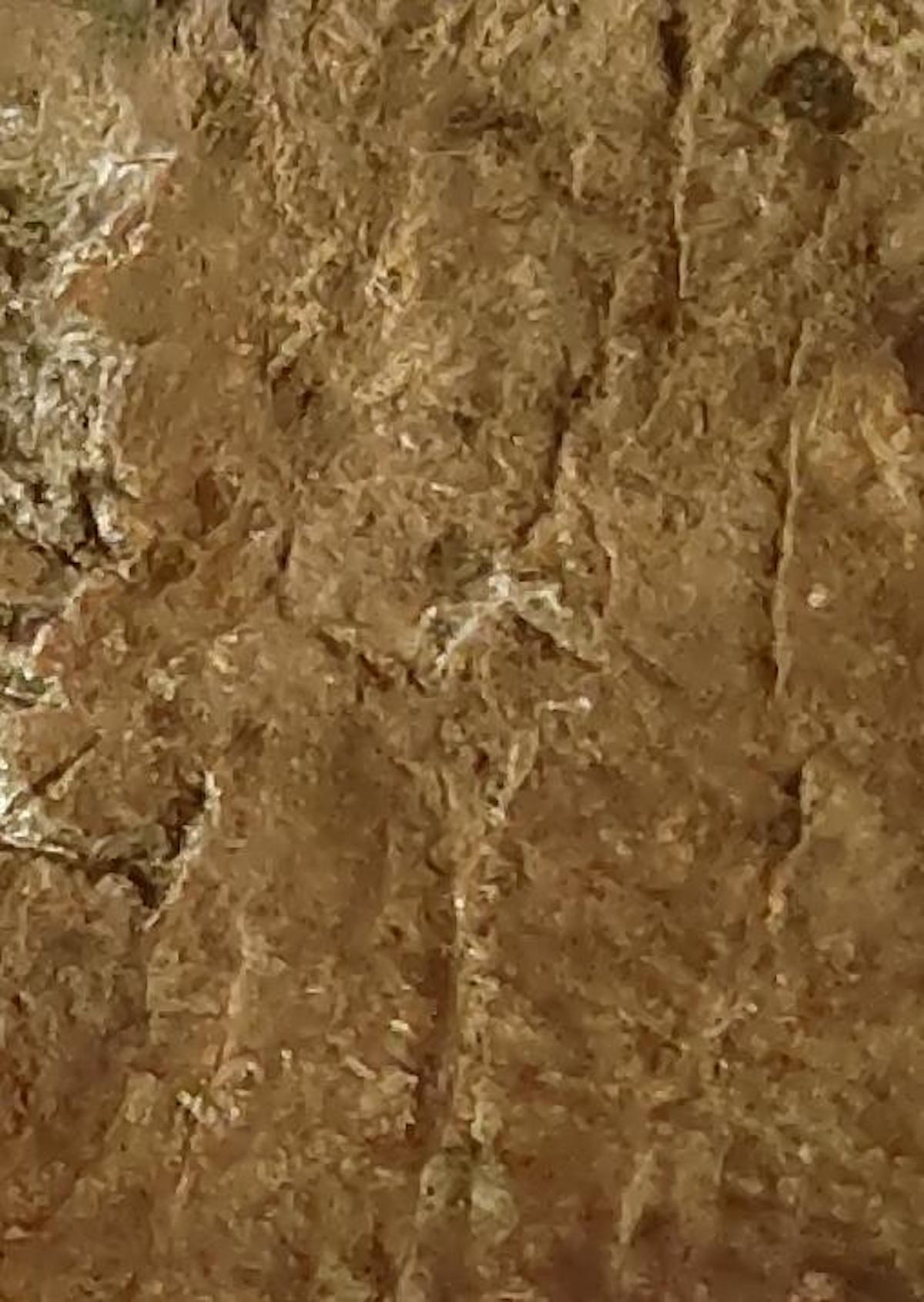
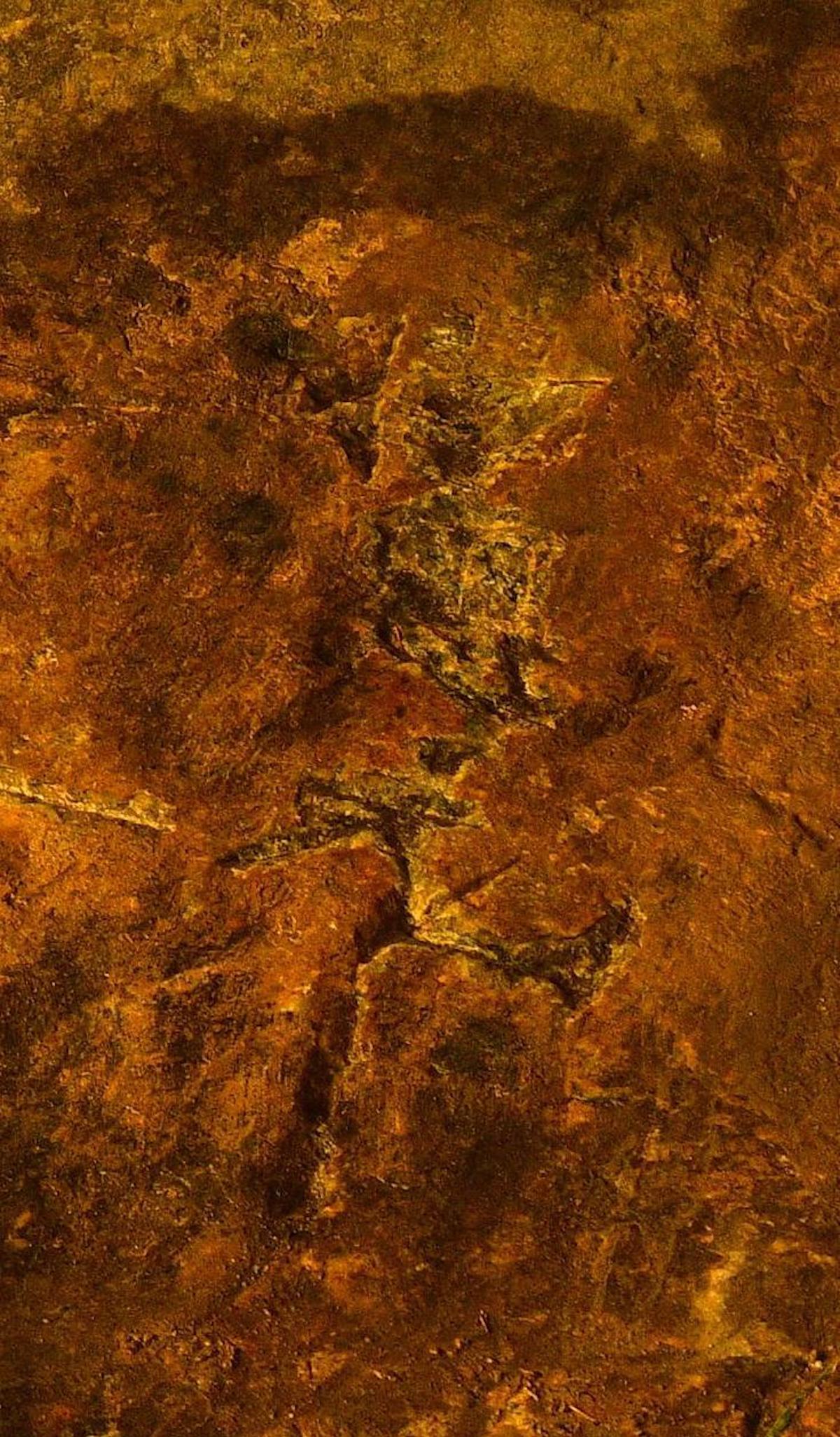


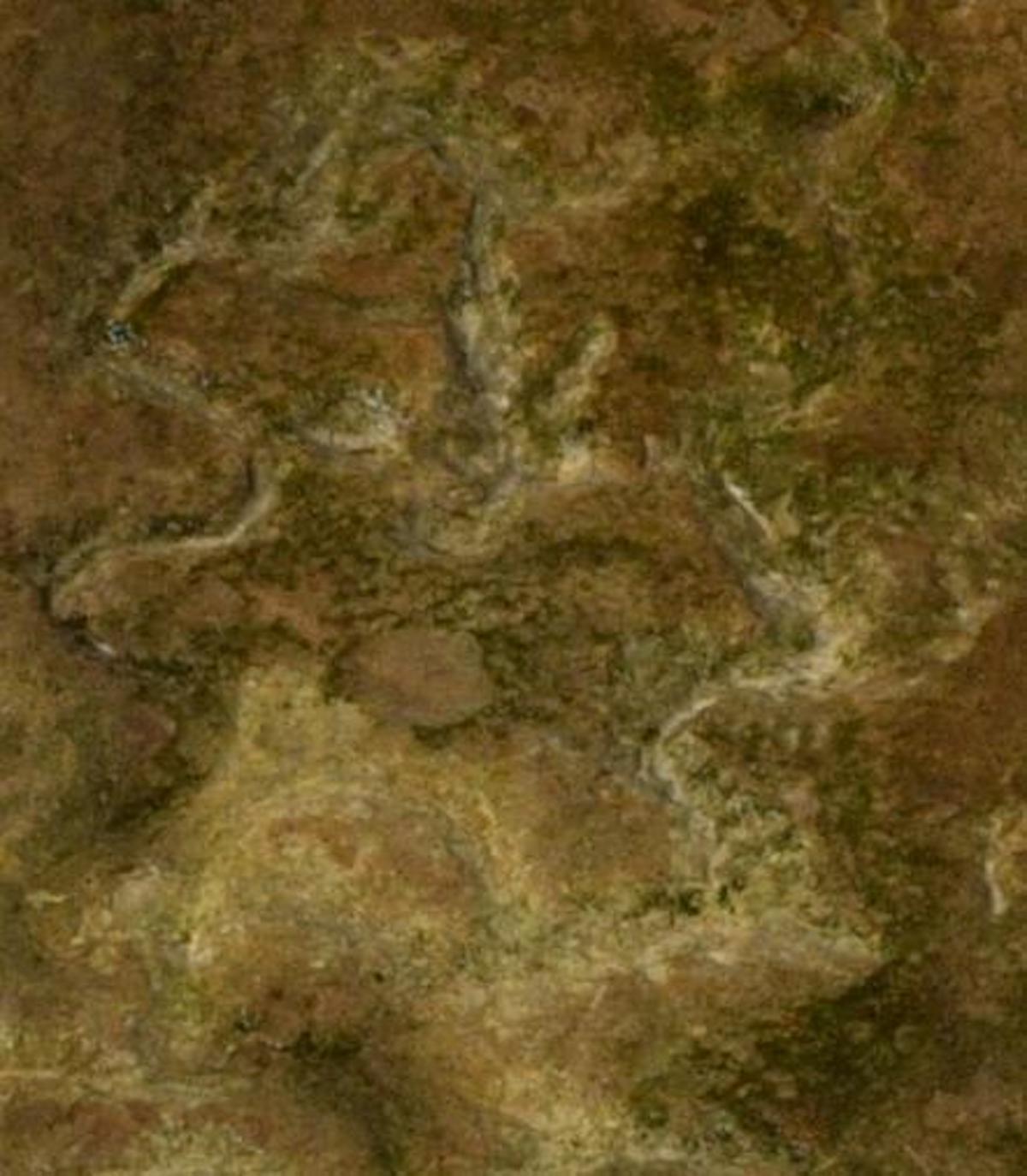


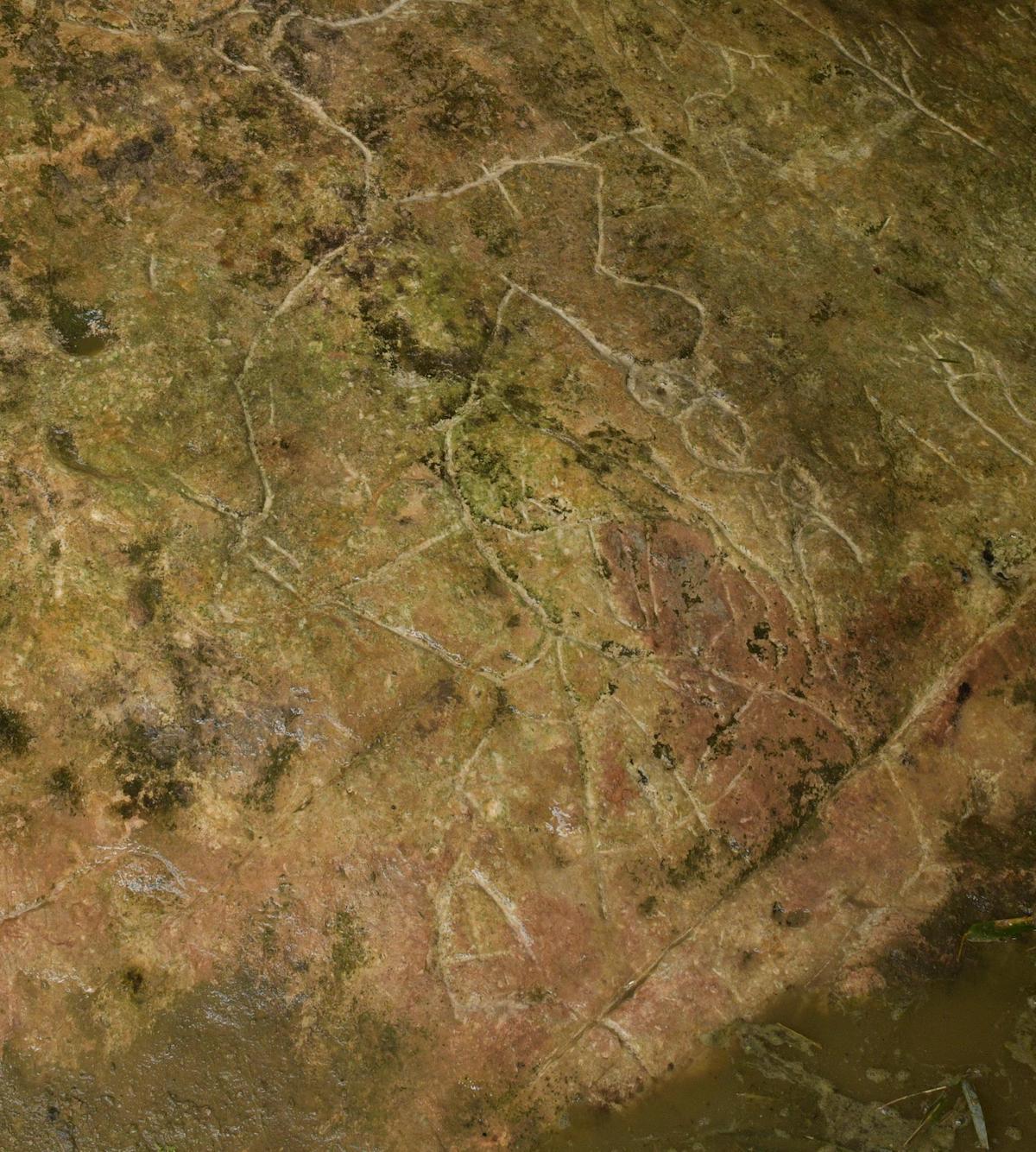


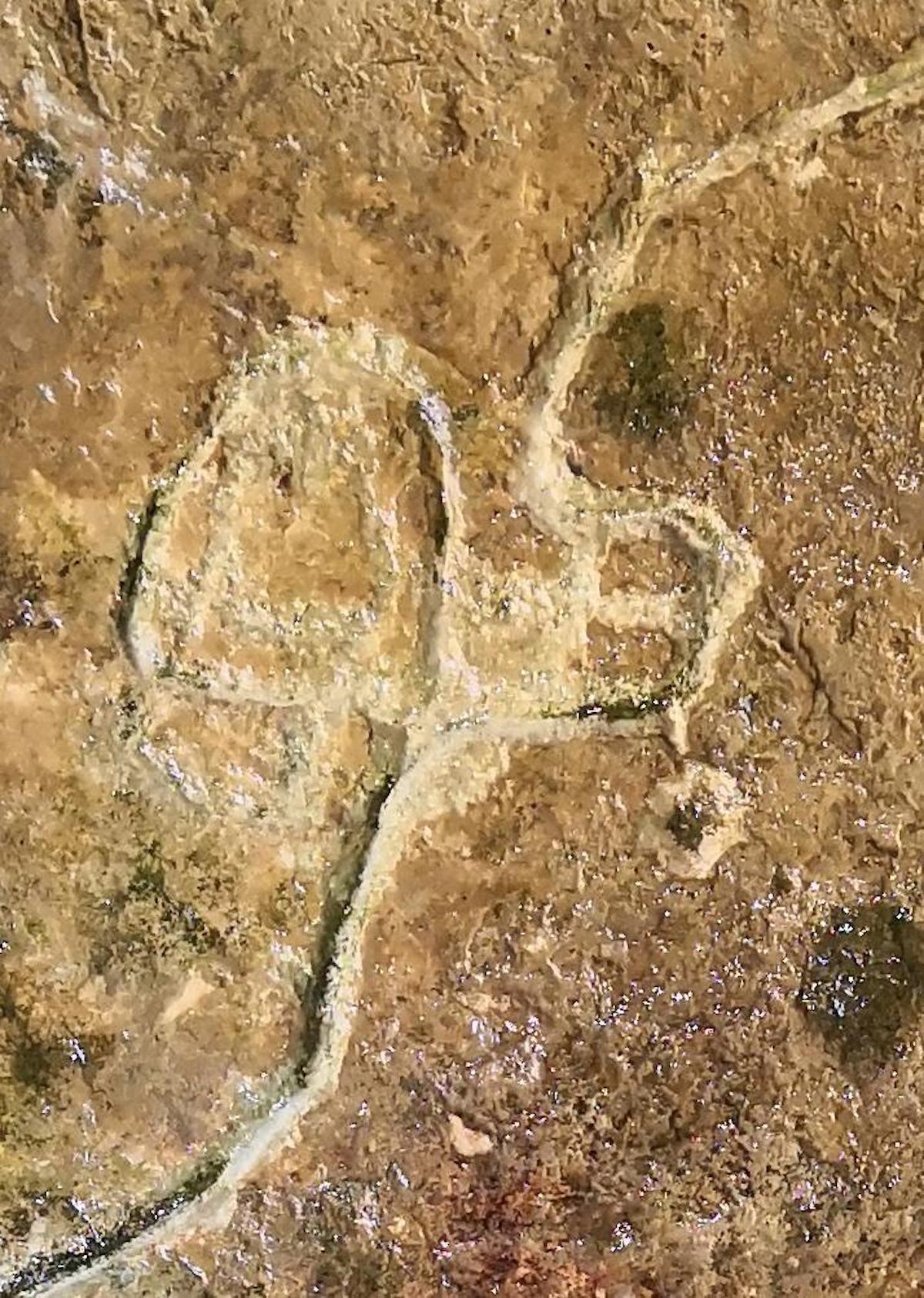

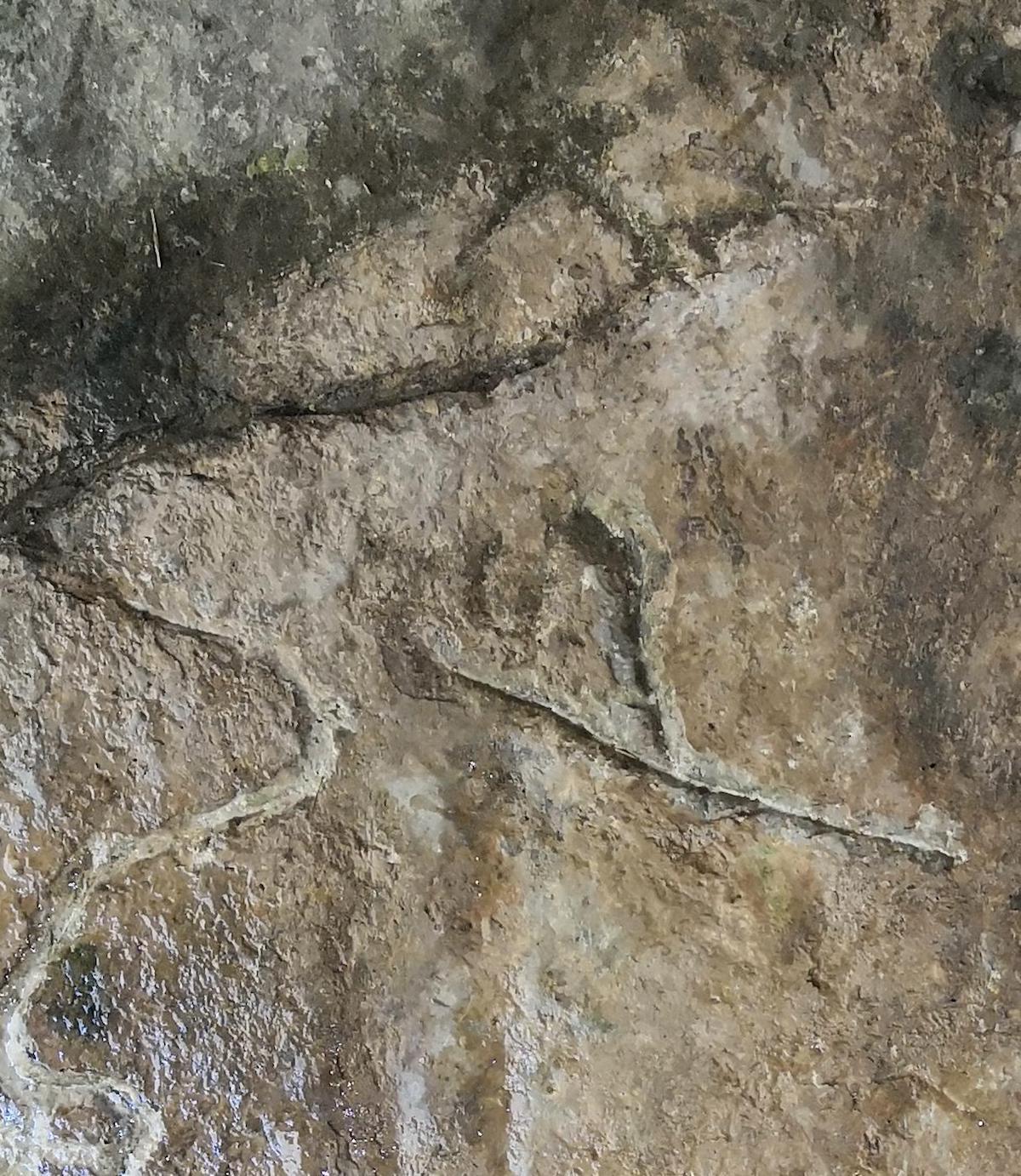
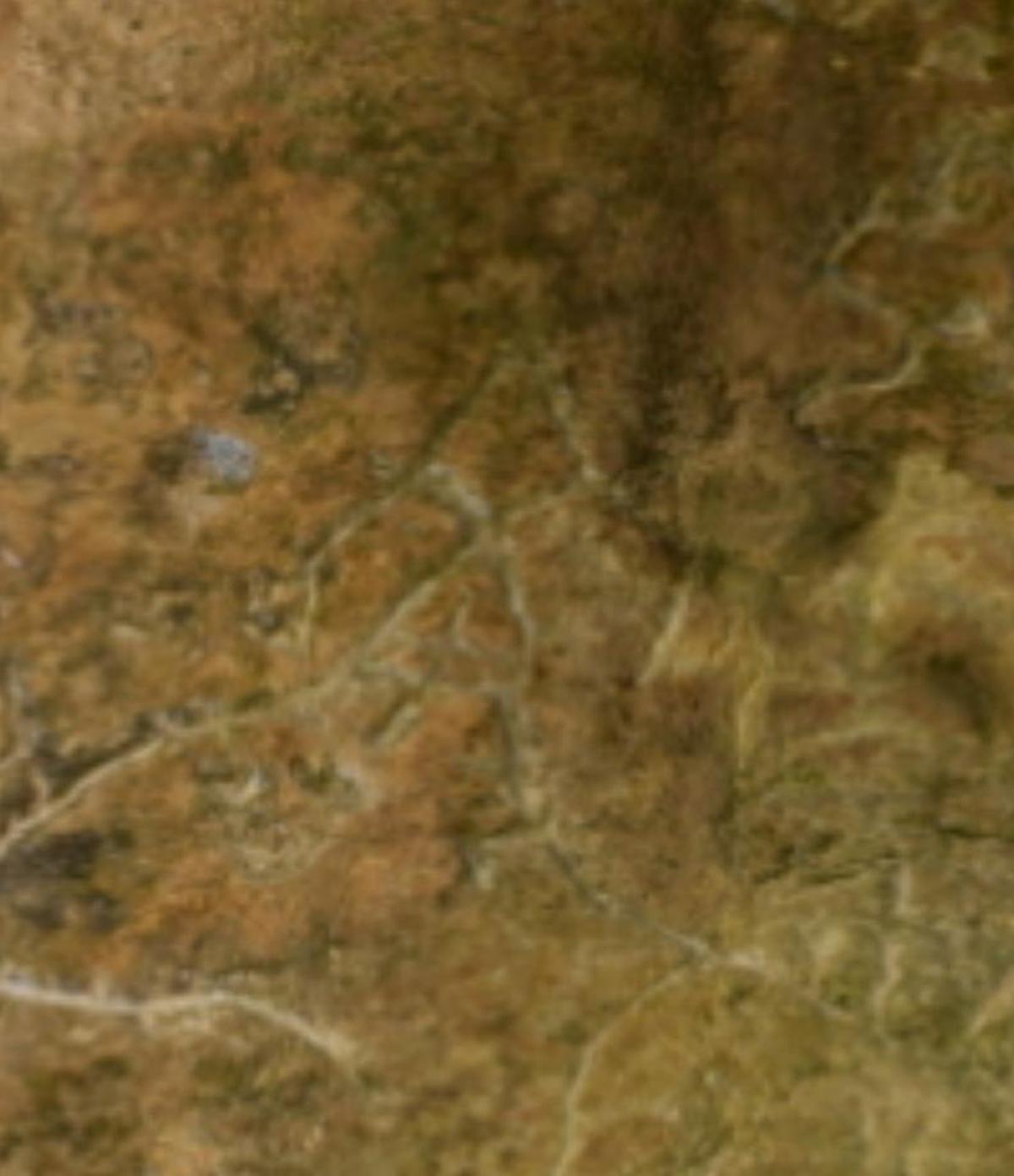

The above three myths, as important contents of prehistoric myths, are engraved in Taishan, a place where gold and silver are produced in ancient sacrifices. From various perspectives, they all conform to the characteristics of prehistoric culture.
Huangzhu, Cheng County, Longnan
Huangzhu Town, Cheng County, Longnan City, Gansu Province is an ancient historical and cultural town, famous for its lead-zinc mine, which ranks second in the country. There is a surviving "Baoli Yongsi Stele" engraved in the thirty-eighth year of Wanli (1610) at Huangzhu Pass, which records the history of the mining and smelting of silver mines in Gao Rusong, the magistrate of Chengxian County, and the quelling of disputes over mines. Huangzhu has a long history of mining metallurgy, silver, copper, tin and iron. In particular, the well-known Xicheng ore field is rich in sphalerite, galena, pyrite, chalcopyrite, tetrahedrite, bornite, etc. Liangdang, Huixian, Xihe, etc. are centered on Huangzhu in Chengxian County. Yanjin and Shajin are widely distributed in river valleys such as Xihan River, Bailong River, Baishui River and Liangdangdong River in Wenxian County, Wenxian County and other places. The gold reserves of Gaolou Mountain in Wenxian County are known as the largest in Asia, and the famous geologist Li Siguang called this place "the treasure area". Wenxian Bikou Tianliang Copper Mine, Kangxian Yangba Copper Mine, Shaanxi Ningqiang Maoping Copper Mine and Xujiaping Copper Mine are all large copper mines. These places are less than 100 kilometers away from Xuanyuan’s hometown of Tianshui Qishou, the capital of the Western Zhou Dynasty, Fengxiang, the hometown of Qin people, Xibei, Baoji, and Xianyang.
The Yanhuang Group belongs to the Xianqiang people and is the predecessor of the Huaxia people. The development history of the Yanhuang Group's migration from the northwest to the east has become the basic point of view of the Three Emperors Theory. The Xuanyuan Kingdom, Xuanyuanqiu, Xuanyuan Valley, Jiangshui, Zhuolu and Qiaoshan recorded in ancient books are all places where the Yellow Emperor resided. "Mandarin • Jinyu IV" says: "The Yellow Emperor is made of Ji Shui, and the Yan Emperor is made of Jiang Shui, so the Yellow Emperor is the Ji, and the Yan Emperor is Jiang." Among them, the word "cheng" is the source of the word "cheng" in ancient Chengzhou and now Chengxian. As the "Baby Zone" and an important pass on the Qishan Ancient Road, the early Yellow Emperor used this place or ordered others to pick and cast copper tripods here.
"Historical Records Six Kingdoms Chronology" contains: "Yu Xing in the Western Qiang". "Mozi: Gengzhu" said: "In the past, after the summer, the emperor sent Minglian to mine gold in the mountains and rivers, and the pottery was cast in the ruins of Kunwu. . . . Qilian, the ancestor of the Qin people, has a history of mining gold (copper) and casting cauldrons. Therefore, in the historical materials of Qin, there are "instructed by heaven, house Yulai (ji)", "following the traces of Yu, and also the world. "Fu", "Jianzhong guides Yang, and the east is Han". The name of the ancient mountain "Jianzhong" is marked in the modern Chinese dictionary in the northeast of Chengxian County ( Note ⑧: "Xinhua Dictionary" 10th edition, page 35 ), which is the boundary of Huangzhu County in Chengxian County.
Su Haiyang, a well-known scholar, said: "During the Xia, Shang and Western Zhou periods, the Xia culture in the Central Plains, Siwa in the northwest, and the early Qin culture were closely related to the early Shu civilization via Tianshui and Longnan. The route forms an international trade channel connecting Sichuan and Shu via South Long and Tianshui via Central Asia, West Asia, and North Asia.” ( Note 9: Su Haiyang and Yong Jichun: “The Formation of the Silk Road Qishan Road from Archaeology”, “Silk Road", No. 4, 2009 ) "It is this special geographical location that makes Longnan's social culture form a distinctive marginality and pluralism. There is a fusion of ancient Di, Qiang and Tibetan cultures and Han cultures. There is also a great intersection of Qin culture and Bashu culture.” ( Note 10: Liu Jiping: “The Legacy of Di and Qiang: The Cultural Origin of the Art of Worshiping Gods in the Adjacent Areas of Shaanxi, Gansu and Sichuan”, Journal of Hubei Institute for Nationalities, No. 4, 2015, page 11 )
in conclusion
Through the above analysis and trial reading, it is preliminarily determined that the Taishan rock paintings of Huangzhu in Chengxian County, Longnan, Gansu are based on three works: "The Yellow Emperor's Ding Chengcheng Riding a Dragon", "Yu's Mother Swallows the Barley Pearl to Give birth to Yu", and "Wuyiyuan Sword and Yaonu" The sacrificial rock paintings with the theme of myths and stories, and with the continuous development of the mining and foundry industry, gradually formed rock paintings integrating symbols, ancient characters and modern characters.
As a multi-ethnic, multi-cultural meeting area and a land rich in resources, Cheng County, Longnan has been approved by the United Nations Geographical Names Expert Group and the Ministry of Civil Affairs of the People's Republic of China in accordance with the "China Geographical Names and Cultural Heritage Identification Standard System" and "The Identification Standard of the Key Protected Objects of Geographical Names and Cultural Heritage" , among the more than 800 ancient counties in China that are over a thousand years old, one of the 100 "thousand-year-old counties" with a long history, profound cultural accumulation and rich cultural connotations of place names has been selected. The petroglyphs with mythological themes found in this area are consistent with the myths and stories of local peoples in ancient times, and should be paid attention to by relevant experts and scholars. At the same time, this rock painting has very important reference value for calligraphy, art, mythology, ethnology and religion.
(The author is a professional policeman, a director of the Calligraphers Association of the National Public Security Federation of Literary and Art Circles, a member of the 4th Bamboo and Slip Committee of the Gansu Calligraphers Association, and a writer of literature and history of the Chengxian County Political Consultative Conference in Longnan.)

On-site inspection Figure 24
Recently, in the Shuangyao narrow one ancient mine cave in Taishan Village, Huangzhu Town, Cheng County, Longnan City, Gansu Province (commonly known as Wifegou Zangjindong), a picture of figures, plants, symbols, etc., made of knocking, grinding, and chiseling was discovered. The rock paintings are covered with oracle bone inscriptions, bronze inscriptions, Weishu, simplified calligraphy and other characters of different periods, and relics such as stone houses, ancient paths and horseshoe-shaped "Laliu Cao" in ancient mineral processing have been found around them.Overview of Taishan Rock Paintings
The rock art is located at the mouth of the ancient mine on the east side of a small stream in Shuangyaoxia, Taishan Village, Huangzhu Town, Chengxian County. Tongkou is about 5 meters high and 6 meters wide, which is unfathomable. The cave body is phyllite, a large amount of loess has poured into the cave due to geological changes, and the high places are plate diagenetic rocks. The petroglyphs are immediately on a slope of the yellow-brown siliceous rock (see Figure 1).

figure 1
The rock paintings are divided into upper and lower parts, the upper left is scattered text and portrait images, and the lower right is a dense rock painting pattern, with a vertical width of 3 meters, a height of 2.5 meters, and a distribution area of about 8 square meters. The characters, graphics and symbols that can be recognized in the rock paintings include: oracle bone inscription "Gao" (see Figure 2), deformed ideographic character "Yu" (see Figure 3), oracle bone inscription "Dan" (see Figure 4), face painting and deformed ideogram Mixed text "Father" (see Figure 5), Suspected Bronze text "龏" (see Figure 6), Wei style "Earth" (see Figure 7); Wei style "Tianxia" (see Figure 8), Wei style "Yang Zhongyuan" (see Figure 9), the suspected character "dou" (see Figure 10), the suspected simplified character "dragon" (see Figure 11), the human-shaped symbol (see Figure 12), the flat-topped side portrait (see Figure 13), the tower shape Paintings (see Figure 14), sitting figures (see Figure 15), crown ornaments and jewel-like symbols (see Figure 16), plants and "dragon whiskers" (see Figure 17), and mine caves (see Figure 18) , dragon and bow and arrow diagrams (see Figure 19), witch-shaped diagrams (see Figure 20), and owl-shaped diagrams (see Figure 21).
Figure 2: Oracle's "Notice"
More than 70 horseshoe-shaped holes were found in the valley and ditch about 30 meters northwest of the rock art. There are more than 30 holes in the upper part of the ditch and about 40 holes in the lower part. To 30 cm, some have one or two small holes of different sizes at the bottom (see Figure 22). These horseshoe-shaped holes are estimated to be relics left by the ancients when flotation of ore. About 40 meters south of the rock painting, there is a section of an ancient path 0.5 meters wide and 8 meters long (see Figure 23) on the riverbank boulders (see Figure 23), and in the middle of the east cliff about 20 meters south of the rock painting, a conjoined double hole was found. , The cave is 4 meters high, 3 meters wide, and about 6 meters deep. The south cave is slightly lower than the north cave. There is a stone platform at the end of the north cave, which can accommodate four or five people to sleep. The cave is well ventilated and lighted. From the entrance of the cave, you can go up to the top of the mountain and down to the valley. This cave should be used by the ancients to live in. (See Figure 24)
Figure 22
Trial reading of text symbolsFigures 2 and 3 show the word "Jiaoyu" carved by chisel and chisel. "Gao" is very similar to oracle bone inscriptions. "Gao" is the original character of "祰". Mouth, which is both the side of the form and the side of the voice, means to speak. The upper part of the oracle bone inscription is "ox" (victim) and the lower part is mouth (prayer), which means offering cows to pray for blessings. Jinwen continued the oracle bone script. In official script, the "ox" in the golden script is written as "report", and the original meaning of "prayer" disappears. Here, the top of "Yu" is slightly decorated with a small crown, and the lower part is in the shape of raindrops, which should be the earliest example of the method of making the word "seeking rain".

Figure 3: Deformed ideogram "Yu"
Figure 4 "Dan" word, consistent with Oracle. Dan, oracle bone inscriptions are the word for things, and the shape of the glyph is to add a sign of things in the middle of the mine to indicate the minerals in the mine. The word "Dan" appears in the ancient mine cave, especially the vertical mark on the lower right of the mine cave map, which should be the specific location of the gold mine or copper mine. These special handwritings are difficult for later generations to establish this meaning and copy, so they should be the original handwriting of the Yin and Shang or earlier periods.
Figure 4: Oracle "Dan"
Figure 5 is a picture and text of "face image" and "father" strokes intertwined. This kind of picture and text borrowing strokes is rarely found. The character "Father" in Jinwen is the father of the axe, and the "Father" in the Taishan rock paintings has become a cross-style writing of the character "Wen", which is similar to the meaning of the character "Yu". The meaning of the wisdom and elegance of an elder.
Figure 5: A mixture of figurative and metamorphic ideographic "father"
Figure 6 is suspected to be "龏", which is similar to the character "Gui" in "Qin Gonggui". "Dian", tripod cover. Gutong "power", a towel that covers things. "Qin Gonggui" is considered by most scholars to be a sacrificial vessel made by Duke Xiang of Qin in 770 BC when the Qin Dynasty in the western border was founded to worship ancestors in the ancestral temple. The west border passes through Qishan Road to 80 kilometers from Huangzhu Pass, and its raw materials should be taken from Taishan Mountain in Huangzhu.
Figure 6: Suspected Jinwen "Dian"
Figures 7, 8, and 9 show the three groups of Wei-style characters, "Earth", "Tianxia" and "Yang Zhongyuan". handwriting left.
Figure 7: Wei Body "Earth"

Figure 8: Wei Style "World"

Figure 9: Wei body "Yang Zhongyuan"
Figures 10 and 11 are suspected to be the words "dou" and "dragon", which are handwritings written on sharp objects, which proves that this place has attracted the attention of the world since ancient times. Figure 12 is a silhouette of a human figure, and Figure 13 is a profile portrait with a flat top. These two images are very similar to the human face in the rock painting of Damaidi in Zhongwei, Ningxia (see Figures 25 and 26). The thickness of the lines and the subtle changes in the virtual and real make the man on the stone full of movement. This sacrificial "artistic schema is an unrealistic humanoid creature, which may have totem meaning." ( Note ① Yang Chao: "A Preliminary Study on the Mythological Dating Method of Rock Paintings - Taking the Rock Paintings of Human Faces in Helan Mountain as an Example", "Three Gorges Forum" ", No. 2, 2012, p. 89 )
Figure 25

Figure 25
Song Yaoliang said in his book "China's Prehistoric Godhead Human Face Rock Paintings": "It can be said for certain that the human face rock paintings are part of the sacrifice. The sacrifice at that time must be divided into two parts: one is the sacrifice ceremony attended by the wizards and the people. The second is to carve the rock paintings, and tell the gods to let the gods know, so that the content of the sacrificial ceremony or prayer can be recognized by religion and law.” ( Note ②: Song Yaoliang: "The Rock Paintings of Prehistoric Godheads and Human Faces in China", Shanghai Sanlian Publishing Bookstore, October 1992, p. 285 ) "Ethnologists, archaeologists, and petroglyphs from all over the world are in the midst of shamanistic religions in the past. In the area, many icon walls composed of faces have been found, which are undoubtedly the images of gods made by ancient wizards. Making god statues and sacrificing god statues to achieve the purpose of 'assimilating natural forces'. This is the main function of sorcerers One of them." ( Note ③: Gai Shanlin: "A Preliminary Study on the Rock Paintings of Wizards in Helan Mountain", "Ningxia Social Science", No. 3, 1992, p. 6 ) It can be seen from this that the faces in Figure 12 and Figure 13 should be Tai The earlier rock paintings in the mountain rock paintings also indicate that this is an important sacrifice site.
Figure 12: Human-shaped symbol

Figure 13: Flat-top sideways portrait
Figures 14, 15, 16, 17, 18, 19, 20, and 21 are a group of mysterious pictures. These figures, plants, symbols, mines, witches, and dragon-shaped symbols cannot be isolated symbols. Rather, it should be the theme of the gods portrayed for sacrifice. Mr. Yuan Ke, a mythologist, said: "Myth is the collection of the cultural thoughts of primitive ancestors." ( Note 4: Yuan Ke: "History of Chinese Mythology", Chongqing Publishing House, 2007, p. 4 ) The writer Shen Bingyan also said: "Our ancient history, at least before Yu, is really a myth." ( Note ⑤: Lu Sixian: "Postscript" to "Mythology and Archaeology", Cultural Relics Publishing House, 1995 edition, p. 369 ) The civilization has a history of only three or four thousand years, and the cultural form before the appearance of writing may have been rock paintings.
Figure 14: Tower painting

Figure 15: Portrait of a sitting figure

Figure 16: Crown and jewel-like symbols

Figure 17: Plants and "dragon whiskers" drawings

Figure 18: Mine tunnel map

Figure 19: Diagram of dragon and bow and arrow
Taishan rock paintings appeared in ancient mine caves. If it is a myth, it should be related to mining and casting. When looking at many myths related to mining and casting, I found that the three myths of "Yellow Emperor Ding Chengcheng Riding a Dragon", "Mother Yu Swallowing Coix Pearls to give birth to Yu", "Wuyi Sword and Maiden" are basically the same as the scenes in Taishan rock paintings. match. "Historical Records Fengchan Book" says: Gongsun Qing said: "The Yellow Emperor plucked the copper from the mountain and cast a tripod at the foot of Jingshan. The tripod was completed, with a dragon hanging beard and beard, and he went down to welcome the Yellow Emperor. The rest of the people. The dragon went up, but the rest of the ministers were not allowed to go up, so they all held the dragon beard, the dragon beard pulled down, and fell to the bow of the Yellow Emperor. The people looked up to the Yellow Emperor since he went to the sky, and they held his bow and bearded name, so the later generations named it as a tripod. The lake, its bow is called Wuhao." It means that after the Yellow Emperor picked copper and made a tripod, a dragon bowed his head to greet him. The Yellow Emperor was riding a dragon, and the dragon was about to fly, but more than seventy of the ministers could not get on it. Then the bow and arrow turned into Sang Zhe, that is, Usain. The Taishan rock paintings include dragons, daggers, dragon whiskers, bows and arrows, and Sang Tuo, among which the dragon-shaped image is similar to the “Taiji Dragon” in the Yahe rock paintings in Nanyang, Henan (see Figure 27). These pictures are likely to be sacrificial petroglyphs in which the "Yellow Emperor" prayed for the safety of the miners.
Figure 27
"Dunjia Kaishan Tu" Rong Shi noted: "The female Di Mu dipped into the spring at the foot of Shi Niu Mountain, and the water obtained the moon essence, like a chicken, and she loved it, swallowed it unconsciously, and then conceived, and in the fourteenth month, Xia Yu was born. ( Note 6: Yuan Ke: "The Great Dictionary of Chinese Mythology", Huaxia Publishing House, August 2015, p. 121 ) In ancient documents, there are many Yu mothers and Xin's daughters, called Di Mo and Xiuji, except for legends. There is a saying that swallowing the spiritual pearl of the moon and conceiving Yu, there is also a saying that eating coix seed is pregnant. The meditator in the Taishan rock painting has a triangular face, unclear facial features, wearing a high and flat crown, similar to the crown ornaments of Qiang women, and staring with a treasure-like object in his hand. These images may be petroglyphs offering sacrifices to "Mother Yu", admonishing Emperor Yu, and the word "Gao Yu" should be the inscriptions on the sacrificial sacrifices of the subsequent rock paintings offering sacrifices to Mother Yu and Empress Yu during the Xia and Shang dynasties.
Figure 20: Witch chart

Figure 21: Goggle chart
Figures 20 and 21 are Wu and Gou pictures. The sorcerer's body is shaped like an oracle bone "Wen", with long hair on the top, and his hands are clenched in a stunned state. The male has a small head and no ornaments, with a wide chest and thin legs, in the shape of pulling a witch to his side and running. The Wuxiang rock painting has nothing to do with the above two myths, but it is similar to the early myth of the ancient Di and Qiang people in Chengxian County, "the Wuyi Sword and the Maiden". "The History of the Western Qiang in the Book of Later Han Dynasty" contains: "The Qiang Wuyi sword was detained by Qin Li at the time and regarded as a slave. I don't know the difference between the sword and the Rong. Afterwards, he died, and the Qin people were eager to pursue it and hid in the cave. It was avoided. The Qiang people said: 'Yuanjian first hid the cave, and the Qin people burned it. There was a scene like a tiger, and it sheltered the fire, so that they could not die. After they came out, they met with the female and they became husband and wife. The female was ashamed of her appearance and was arrested The Qiang people died in Sanhejian because they thought it was customary. 'When the Qiang saw that the Yuan sword was burned to death, they blamed their gods, and they were all afraid of it, and they were proud of it." The Qiang people thought it was customary." ( Note ⑦: Zhao Kuifu: "The Origin of the Three-eyed God and the Di Nationality" Literature and History Publishing House, June 1997 ) The Qiang people called the slave "Wuyi" and the leader "Yuanjian", so it was called "Wuyi Yuanjian". Yuanjian learned many agricultural techniques when Qin was a slave, and when he escaped and was in danger, he was rescued by a tiger-shaped monster covering the flames. part. The second picture of Wu He may be a rock painting carved by the ancestors of the Di and Qiang when they offered sacrifices to their ancestors with swords.The above three myths, as important contents of prehistoric myths, are engraved in Taishan, a place where gold and silver are produced in ancient sacrifices. From various perspectives, they all conform to the characteristics of prehistoric culture.
Huangzhu, Cheng County, Longnan
Huangzhu Town, Cheng County, Longnan City, Gansu Province is an ancient historical and cultural town, famous for its lead-zinc mine, which ranks second in the country. There is a surviving "Baoli Yongsi Stele" engraved in the thirty-eighth year of Wanli (1610) at Huangzhu Pass, which records the history of the mining and smelting of silver mines in Gao Rusong, the magistrate of Chengxian County, and the quelling of disputes over mines. Huangzhu has a long history of mining metallurgy, silver, copper, tin and iron. In particular, the well-known Xicheng ore field is rich in sphalerite, galena, pyrite, chalcopyrite, tetrahedrite, bornite, etc. Liangdang, Huixian, Xihe, etc. are centered on Huangzhu in Chengxian County. Yanjin and Shajin are widely distributed in river valleys such as Xihan River, Bailong River, Baishui River and Liangdangdong River in Wenxian County, Wenxian County and other places. The gold reserves of Gaolou Mountain in Wenxian County are known as the largest in Asia, and the famous geologist Li Siguang called this place "the treasure area". Wenxian Bikou Tianliang Copper Mine, Kangxian Yangba Copper Mine, Shaanxi Ningqiang Maoping Copper Mine and Xujiaping Copper Mine are all large copper mines. These places are less than 100 kilometers away from Xuanyuan’s hometown of Tianshui Qishou, the capital of the Western Zhou Dynasty, Fengxiang, the hometown of Qin people, Xibei, Baoji, and Xianyang.
The Yanhuang Group belongs to the Xianqiang people and is the predecessor of the Huaxia people. The development history of the Yanhuang Group's migration from the northwest to the east has become the basic point of view of the Three Emperors Theory. The Xuanyuan Kingdom, Xuanyuanqiu, Xuanyuan Valley, Jiangshui, Zhuolu and Qiaoshan recorded in ancient books are all places where the Yellow Emperor resided. "Mandarin • Jinyu IV" says: "The Yellow Emperor is made of Ji Shui, and the Yan Emperor is made of Jiang Shui, so the Yellow Emperor is the Ji, and the Yan Emperor is Jiang." Among them, the word "cheng" is the source of the word "cheng" in ancient Chengzhou and now Chengxian. As the "Baby Zone" and an important pass on the Qishan Ancient Road, the early Yellow Emperor used this place or ordered others to pick and cast copper tripods here.
"Historical Records Six Kingdoms Chronology" contains: "Yu Xing in the Western Qiang". "Mozi: Gengzhu" said: "In the past, after the summer, the emperor sent Minglian to mine gold in the mountains and rivers, and the pottery was cast in the ruins of Kunwu. . . . Qilian, the ancestor of the Qin people, has a history of mining gold (copper) and casting cauldrons. Therefore, in the historical materials of Qin, there are "instructed by heaven, house Yulai (ji)", "following the traces of Yu, and also the world. "Fu", "Jianzhong guides Yang, and the east is Han". The name of the ancient mountain "Jianzhong" is marked in the modern Chinese dictionary in the northeast of Chengxian County ( Note ⑧: "Xinhua Dictionary" 10th edition, page 35 ), which is the boundary of Huangzhu County in Chengxian County.
Su Haiyang, a well-known scholar, said: "During the Xia, Shang and Western Zhou periods, the Xia culture in the Central Plains, Siwa in the northwest, and the early Qin culture were closely related to the early Shu civilization via Tianshui and Longnan. The route forms an international trade channel connecting Sichuan and Shu via South Long and Tianshui via Central Asia, West Asia, and North Asia.” ( Note 9: Su Haiyang and Yong Jichun: “The Formation of the Silk Road Qishan Road from Archaeology”, “Silk Road", No. 4, 2009 ) "It is this special geographical location that makes Longnan's social culture form a distinctive marginality and pluralism. There is a fusion of ancient Di, Qiang and Tibetan cultures and Han cultures. There is also a great intersection of Qin culture and Bashu culture.” ( Note 10: Liu Jiping: “The Legacy of Di and Qiang: The Cultural Origin of the Art of Worshiping Gods in the Adjacent Areas of Shaanxi, Gansu and Sichuan”, Journal of Hubei Institute for Nationalities, No. 4, 2015, page 11 )
in conclusion
Through the above analysis and trial reading, it is preliminarily determined that the Taishan rock paintings of Huangzhu in Chengxian County, Longnan, Gansu are based on three works: "The Yellow Emperor's Ding Chengcheng Riding a Dragon", "Yu's Mother Swallows the Barley Pearl to Give birth to Yu", and "Wuyiyuan Sword and Yaonu" The sacrificial rock paintings with the theme of myths and stories, and with the continuous development of the mining and foundry industry, gradually formed rock paintings integrating symbols, ancient characters and modern characters.
As a multi-ethnic, multi-cultural meeting area and a land rich in resources, Cheng County, Longnan has been approved by the United Nations Geographical Names Expert Group and the Ministry of Civil Affairs of the People's Republic of China in accordance with the "China Geographical Names and Cultural Heritage Identification Standard System" and "The Identification Standard of the Key Protected Objects of Geographical Names and Cultural Heritage" , among the more than 800 ancient counties in China that are over a thousand years old, one of the 100 "thousand-year-old counties" with a long history, profound cultural accumulation and rich cultural connotations of place names has been selected. The petroglyphs with mythological themes found in this area are consistent with the myths and stories of local peoples in ancient times, and should be paid attention to by relevant experts and scholars. At the same time, this rock painting has very important reference value for calligraphy, art, mythology, ethnology and religion.
(The author is a professional policeman, a director of the Calligraphers Association of the National Public Security Federation of Literary and Art Circles, a member of the 4th Bamboo and Slip Committee of the Gansu Calligraphers Association, and a writer of literature and history of the Chengxian County Political Consultative Conference in Longnan.)
Related Posts